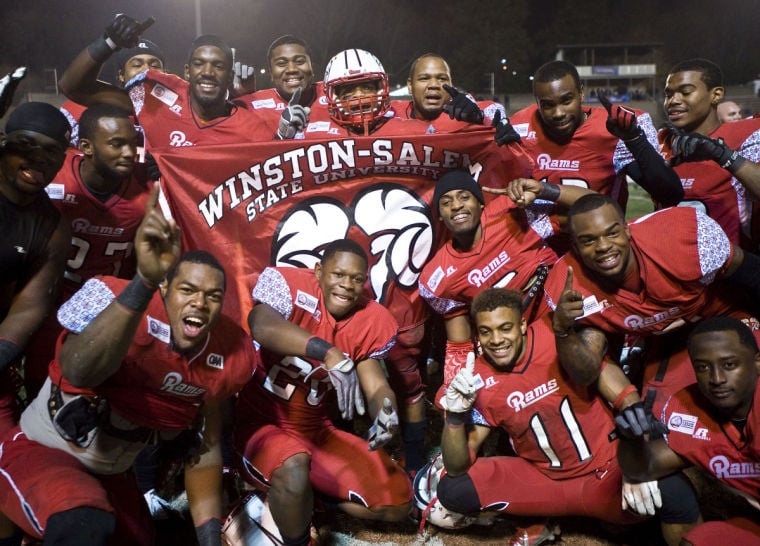 |
| Bethune-Cookman was the lone HBCU to participate in the 2012 Football Championship Subdivision Playoffs. (BCU Photo) |
The Sheridan Broadcasting Network released its annual preseason Black College Football poll last month with defending Division II Runner-Up Winston-Salem State on top. As it has every year since it began in 1981, the SBN grouped all HBCUs in the same Top Ten poll, regardless of NCAA Division. No big deal, right?
Well, it depends on who you asked.
Some observers feel that grouping the schools together regardless of division is archaic at best, and irrelevant at worst. Their argument, for the most part, is that since the schools listed play in both Division I and Division II, that putting them in the same poll is unfair and inaccurate.
The question to those fans is, what have Division I/FCS HBCUs done to separate themselves from Division II HBCUs?
Over the past two years, Winston-Salem State, the top-ranked team in the Sheridan poll, has won five games in the Division II playoffs. That’s five more than the 23 HBCUs competing in the FCS have won in the past decade. Simply put, the larger schools haven’t done much to distinguish themselves from their HBCU counterparts.
Make no mistake about it, there are stark differences between Division I and II. One big hurdle that Division I schools have to deal with is the recently instituted Academic Progress Rate (APR) which penalizes teams that don’t measure up to overall academic standards over a period of time. Alabama State, North Carolina A&T and Hampton are a few of HBCUs that have experienced postseason bans as a result of low APR, something Division II schools don’t have to deal with.
And of course, there is the money issue. Compared to their counterparts at the FCS level, most HBCUs lag far behind in terms of resources. So in turn, many of them have to rely on money games in football to help make up the difference. So that’s why you see a Savannah State taking on Florida State, or Norfolk State taking on Rutgers. These games are good for these school’s bottom line, but little else. Many will argue that playing these teams will make their team better by virtue of competition. I say wake me up when it happens.
 |
| Winston-Salem State became the second HBCU to advance to the Division II National Championship game in 2013. (WS Journal photo) |
Florida A&M won the inaugural Division I-AA championship back in 1978, and joined the MEAC a year later. Back in the late 90s, they won a few playoff games, advancing to the national semifinals in 1999. Actually, FAMU has two of the four MEAC playoff wins since the division expanded to a 16-team format in 1986. No HBCU has won a FCS playoff game since FAMU’s win in ’99.
The SWAC, the other all-HBCU conference in Division I, opted out of the playoffs in ’99 and has chosen to concentrate mostly on classics and its conference championship game. The MEAC has seen team-after-team blow through the conference schedule only to see it falter under the bright playoff lights.
So yes, FCS HBCUs do have a more difficult road to success than their Division I counterparts. But in the 20-30 years that most of these schools have been in Division I, it seems as if they are going backwards or running-in-place instead of moving forward.
One needs to look no further than this weekend to see why FCS HBCUs struggle for respect in their own division. On a weekend where several FCS teams upended FBS teams, these schools went a combined 0-11 against teams from Predominately White Institutions (PWIs). In a division that seems to be getting better every year, HBCUs are struggling to keep pace.
Simultaneously, games against Division II opponents not only offer these schools their best chances for a win, they also pay tend to pay off in the box office. Case in point, a scheduling conflict caused Norfolk State to have to drop its annual Labor Day Classic with in-state rival Virginia State and replace them with Maine. The contrast between the two games were night and day. Norfolk State lost 23-6 to Maine last week after beating Virginia State 24-0 last September. Perhaps the best evidence that putting a gap between FCS and Division II schools may not be a good thing showed at the gate. Just 8,881 fans showed up for NSU and Maine, while 24,322 watched the former CIAA foes duke it out in 2012. That’s almost a three-to-one attendance figure and a win.
I’m not going to do like many in the HBCU community and say that these schools should all drop to Division II. I’d love to see a Bethune-Cookman, or a Howard or FAMU break through and put together a title run the same way Winston-Salem State did at a lower level. Of course, that will be more difficult, but if these are the best that HBCU sports has to offer and they can’t do it, what does that say about HBCU football?
HBCU FCS schools want respect. I get that. The bottom line is, we’re talking about sports. You don’t get points for showing up. Winning when it counts, in the playoffs, is all that really matters. Once HBCUs show that they can become contenders on the FCS level, the difference between the two will be clear. Until that happens, the line between FCS and Division II HBCUs will continue to be blurred.
Good post. Several good points made. But the BIG point is the APR implications.